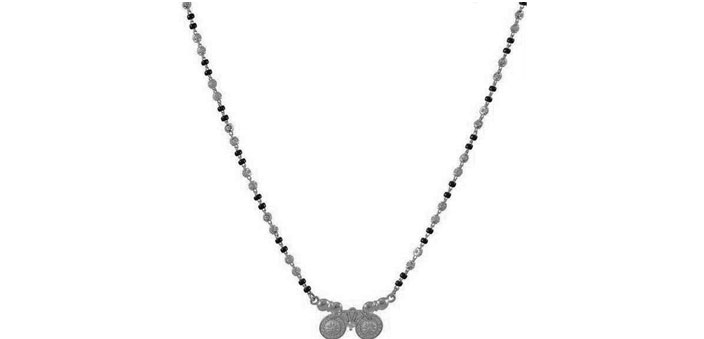In an age where the world is your oyster, and where cultural and ethnic schisms are getting increasingly blurred, it would be interesting to focus on the significance of a marriage symbol – the mangalsutra. This is a ritualistic symbol that gives a woman identification and recognition of her married state. In other words, a single girl or a widowed woman does not wear the mangalsutra. Though over time, the mangalsutra (‘mangal’ meaning ‘auspicious’ and well-being and ‘sutra’ meaning ‘thread’) has transcended socially constructed barriers of ethnicity, culture, language, caste and geography, this black-beaded chain woven together on a single string of gold with one or three little semi-circular bowls of gold defining the pendant is universally identified with the Maharashtrian bride. This chain spreads itself widely in the south-western parts of India but it changes in texture, colour, design and shape from one region to another.
The marital significance
The mangalsutra is generally knotted around the bride’s neck thrice by the groom. Three knots symbolise three different aspects of a married woman – the first knot represents her obedience to her husband, the second to his parents and the third represents her respect for God. Marriage is a sacrament, which brings about a union of two personalities into one, for the purpose of social proliferation and for the upliftment of the two through mutual co-operation. It is a rich heritage soaked with the promise of eternity. It carries forward traces of an indelible past into the present that will hopefully shape our tomorrows.
The mangalsutra is not the only chain the bride wears. She also wears around her neck, as a matter of tradition rather than a part of mandatory ritual and custom, the best in jewellery that forms part of her trousseau. Though this is predominant among Maharashtrians, it is also part of marriage symbols in the south, in Karnataka where it is called the mangalsutra differing somewhat from the Maharastrian one. These are – the pearl tanmani, the exquisitely filigreed mahurat-mani, strings of gold beads in a mohanmaal and bormaal, the geometrically aligned chinchpeti, the lakshmihaar and the putlyachi maal, to name a few. But the Maharashtrian woman’s black-beaded mangalsutra has become a national symbol of a married woman. “The mangalsutra is a symbol of a wife’s devotion and is worn as an amulet to ward off evil. It is believed to have the shakti (power) to attract all that is auspicious and favourable. The semi-spherical bowls that define the pendant could be one or three, depending either on the traditions of the groom’s family or on its choice,” explains Lakshmidas Bhatt, a priest who has been performing and presiding over Maharashtrian weddings for more than two decades now.
The groom ties it around the neck of the bride on the day of their marriage signifying their union at an auspicious moment picked out by the priest from the holy book known as the panchang. “My grandmother told me that each black bead stands for one year of the husband’s life. But I am not sure about the authenticity of this belief or whether it is backed up by scriptures,” says Priya Das, who married a Bengali and does not wear the mangalsutra as a regular habit.
South Indians wear a different version. It is a simple gold chain necklace with a large pendant at the bottom called the thali. The pendant is unique to the particular family/community/caste that you have married into. It is said to be gifted by the relatives on the groom’s side.
The mangalsutra is a token of dignity and love given to a bride by her groom. The most common type is made of two strings of small black beads with a locket or pendant. It is also made of small beads of gold and black beads with a gold and diamond pendant. The black beads signify protection from evil power.
It is believed to protect the marriage and the life of the husband. It is considered auspicious for married women to wear mangalsutra after marriage. In fact, many years ago, there was a film in Hindi called Mangalsutra starring Rekha.
Today, the concept of wearing a mangalsutra has changed. It is more of a fashion statement than a symbol of marriage. The credit goes to daily soaps and to Hindi films. Styles and designs have mutated over the years. Earlier, women would wear simply designed mangalsutras with small pendants. The trend is to wear short-length chains woven with a single string. Instead of gold pendants, modern brides choose diamond pendants. But the black beads remain constant. Whatever may be the reason, the mangalsutra symbolises the real essence and concept of a marriage in some regions in India. Earlier, women wore heavy and elaborate gold mangalsutras. The trend today is to wear short, sleek and single string ones with small designer diamond pendants. However, the black beads remain to ward off the evil and uphold the sanctity of marriage as a socially sanctified institution.


 [/column]
[/column]